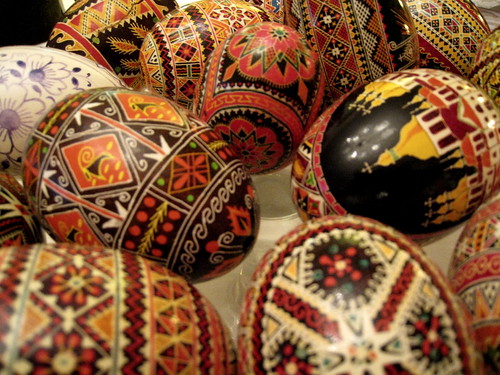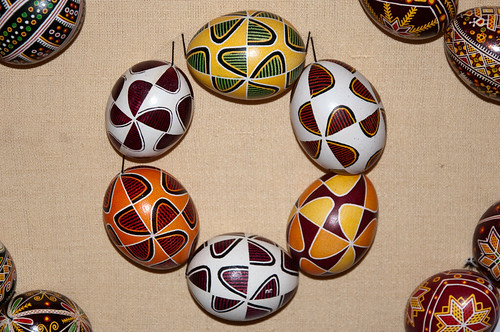Permaculture looks to be the next evolution in agriculture taking organic to another level. The focus on diversity and micro-climates to overcome hurdles where chemicals and fans/heaters are used in conventional agriculture.
Friday, October 22, 2010
Thursday, October 21, 2010
Colony Collapse Disorder prevention turns out to be easy
Common sense explanation of CCD and the problems with commercial beekeeping methods. Probably not dramatic enough to be on the front page of the New York Times.
Friday, October 15, 2010
Modern agriculture: higher yields lower nutrition, for everyone.
Bees may be dealing with some of the same issues humans with respect to the nutrition that is coming from our orchards and fields. As harvest yields have been steadily increasing over the decades there has a decrease in the amount of vitamins and minerals in many fruits and vegetables.
From the National health foundation:
What happens when you revert back to more traditional methods of agriculture like the organic movement? The crop yields may go down but premium that organic farmers get can make up the difference. In the study below it is shown that organic produce does contain more nutritional value than conventionally grown agriculture.
Nutritional Superiority of Organic Foods
Where does this all lead us? It is difficult enough in our fast food culture to eat well and maintain a budget along with a waistline. The prices of fresh fruits and vegetables and meat are rising almost twice as fast as other foods according to a recent University of Washington study. Supporting organic agriculture especially through a CSA (community supported agriculture). Find a CSA in your area here.
To bring this back to the decline of the bee population since the number of American hives peaked in 1980; conventional agriculture is heavily dependent on mono-cultures and use pollinators to increase crop yield. I am not going to make the correlation means causation argument with CCD and the general decline in bees, but if nutrition is declining in conventionally grown produce why wouldn't other parts of the plant decline as well? Specifically if fruits and vegetables have declining nutrients why wouldn't pollen and nectar from the flowers; the things that the bees depend upon. Beekeepers using organic and natural methods are not being hit by colony collapse disorder in the magnitude that conventional beekeepers are in conventionally grown agricultural areas. I am sure that there are many contributing factors to CCD and the general decline of bees but declining nutrition in pollen and nectar that the bees depend upon for survival sure can't help. Studies need to be done to analyze the effect of nutrition on bees, but if you ever seen the movie "super size me" a diet of a single type of food (monoculture) doesn't lead to health out comes.
The pendulum has begun to swing back towards sustainability but modern agriculture does have its benefits like being able to feed an ever growing world population: finding the right mix for people and the environment alike is the critical question.
From the National health foundation:
To get the same calcium content from fresh veggies today as when JFK was president, you'd have to eat twice as much broccoli. To get the same amount of iron as when the Beatles were singing "We All Live in a Yellow Submarine," you'd have to eat four times as many collard greens. To maintain your vitamin A and C levels under the next administration, it will take three times as much cauliflower and twice as much watercress as during the Nixon and Watergate era. These are a few of the conclusions gleaned from comparing the U.S. government's food composition tables from the 1960s and 1970s to the present day.
Similar studies in Europe have come to the same conclusion, and calls by scientists and journalists for any follow up data have inspired me to undertake research and analysis of several other food groups. For this article, I have investigated the nutrient loss in fresh fruits over the last 25 years. In a recent experiment, I compiled a "digital fruit basket" of twelve common fruits and compared their nutrient content today with that published in Handbook #8 issued by the USDA in 1975. Like the sample of twelve random vegetables I investigated earlier, I found that the fruits have lost a major share of their vitamins and minerals. Overall, vitamin C levels are off 1.9%, vitamin A levels are down 16.4%, phosphorus has diminished 23.9%, calcium content has fallen 28.9%, and iron levels have plunged 47.6%.Over time much of our fresh food is losing its nutritional values. Just as economist often tout that people respond to incentives, industrial farming has followed suit. Large agriculture gets paid by the pound of produce not the milligram of vitamins and minerals. This incentive has pushed yields per acre and farmers are continually looking to maximize tonnage to bring to market. Hybrids, GMO's and chemical fertilizers have helped boost yields and continues to make America's farmland the most "productive" in the world.
The vitamin A in apples, for example, dropped 41%, strawberries lost 55%, and that in grapefruit plunged 87.5%. Vitamin C fared better, with minor losses in a majority of the fruits, though that in cherries was off a hefty 30% and lemons dropped 31.2%. Grapefruit, also significantly down in calcium and iron, has particularly lost its vitality. This may be the result of pollution in the Everglades (caused primarily by run off from sugar refining). The vitamin levels in oranges, Florida's other top crop, remained constant, but its iron content fell 75%.
What happens when you revert back to more traditional methods of agriculture like the organic movement? The crop yields may go down but premium that organic farmers get can make up the difference. In the study below it is shown that organic produce does contain more nutritional value than conventionally grown agriculture.
Nutritional Superiority of Organic Foods
Where does this all lead us? It is difficult enough in our fast food culture to eat well and maintain a budget along with a waistline. The prices of fresh fruits and vegetables and meat are rising almost twice as fast as other foods according to a recent University of Washington study. Supporting organic agriculture especially through a CSA (community supported agriculture). Find a CSA in your area here.
To bring this back to the decline of the bee population since the number of American hives peaked in 1980; conventional agriculture is heavily dependent on mono-cultures and use pollinators to increase crop yield. I am not going to make the correlation means causation argument with CCD and the general decline in bees, but if nutrition is declining in conventionally grown produce why wouldn't other parts of the plant decline as well? Specifically if fruits and vegetables have declining nutrients why wouldn't pollen and nectar from the flowers; the things that the bees depend upon. Beekeepers using organic and natural methods are not being hit by colony collapse disorder in the magnitude that conventional beekeepers are in conventionally grown agricultural areas. I am sure that there are many contributing factors to CCD and the general decline of bees but declining nutrition in pollen and nectar that the bees depend upon for survival sure can't help. Studies need to be done to analyze the effect of nutrition on bees, but if you ever seen the movie "super size me" a diet of a single type of food (monoculture) doesn't lead to health out comes.
The pendulum has begun to swing back towards sustainability but modern agriculture does have its benefits like being able to feed an ever growing world population: finding the right mix for people and the environment alike is the critical question.
CCD cause found; Point, Counterpoint
Recently the New York Times ran an article detailing how the cause of colony collapse disorder had been discovered. It is linked to a fungus and a virus. The research paper can be found here.
The Times distills it down to:Abstract
In 2010 Colony Collapse Disorder (CCD), again devastated honey bee colonies in the USA, indicating that the problem is neither diminishing nor has it been resolved. Many CCD investigations, using sensitive genome-based methods, have found small RNA bee viruses and the microsporidia, Nosema apis and N. ceranae in healthy and collapsing colonies alike with no single pathogen firmly linked to honey bee losses.
Conclusions/Significance
These findings implicate co-infection by IIV and Nosema with honey bee colony decline, giving credence to older research pointing to IIV, interacting with Nosema and mites, as probable cause of bee losses in the USA, Europe, and Asia. We next need to characterize the IIV and Nosema that we detected and develop management practices to reduce honey bee losses.
Dr. Bromenshenk’s team at the University of Montana and Montana State University in Bozeman, working with the Army’s Edgewood Chemical Biological Center northeast of Baltimore, said in their jointly written paper that the virus-fungus one-two punch was found in every killed colony the group studied. Neither agent alone seems able to devastate; together, the research suggests, they are 100 percent fatal.
This is a very significant finding and will lead to developing new methods to deal with colony collapse. Since a cause of CCD will give new avenues to deal specifically with the virus and/or the fungus. My feeling though is, this can reduce CCD but the honeybee population has been on the decline since 1980 well before CCD. If we get back to the pre-ccd downtrend in bee populations we will be out of the free-fall but still on the decline. Mites, pesticides and other know viruses are still a lot to deal with. Hopefully a diagnosis of CCD won't cause complacency and lack of research into what ails honeybees.
And now on the counterpoint side of the research:
Correlation is not causation plus Follow the Money.
Fortune magazine was one of the first to expose that the explanation is does not fill all the holes in the ccd riddle though it does make for a nice packaged story to put on their front cover.
Bromenshenk's study acknowledges that the research does not "clearly define" whether the concurrent virus and fungus, which were found in all the afflicted bee samples, is "a marker, a cause, or a consequence of CCD." It also notes uncertainty as to how, exactly, the combination kills the bees, and whether other factors like weather and bee digestion play a role. Scientists like Sass at NRDC believe the mystery is far from resolved: "We're even concerned that based on this, beekeepers will use more pesticides trying to treat these viruses," says Sass.also conflicts of interests were brought up in the scope of the study which did not include pesticides as a contributor to CCD. To use HIV as an example, the HIV virus itself doesn't kill people, it weakens the immune system making it susceptible to deadly diseases. It is no stretch to think of pesticides as the same, reducing the immune systems of honeybee colonies. What does strike me is that still the percent of hives lost in the hardest hit areas are agricultural not urban, suburban and organic operations i.e. areas where pesticides are used the most. There can be other explanations than pesticides but testing for pesticide levels in the bees that succumbed would be more enlightening and make for a more robust study.
Not dealing with pesticides seems to stirred up some conflict of interest questions.
The long list of possible suspects has included pests, viruses, fungi, and also pesticides, particularly so-called neonicotinoids, a class of neurotoxins that kills insects by attacking their nervous systems. For years, their leading manufacturer, Bayer Crop Science, a subsidiary of the German pharmaceutical giant Bayer AG , has tangled with regulators and fended off lawsuits from angry beekeepers who allege that the pesticides have disoriented and ultimately killed their bees. The company has countered that, when used correctly, the pesticides pose little risk.
What the Times article did not explore -- nor did the study disclose -- was the relationship between the study's lead author, Montana bee researcher Dr. Jerry Bromenshenk, and Bayer Crop Science. In recent years Bromenshenk has received a significant research grant from Bayer to study bee pollination. Indeed, before receiving the Bayer funding, Bromenshenk was lined up on the opposite side: He had signed on to serve as an expert witness for beekeepers who brought a class-action lawsuit against Bayer in 2003. He then dropped out and received the grant.A study that points the cause of CCD toward a virus and fungus is definitely less controversial with heavily monied interests like pharma companies than pointing to pesticides. Viruses don't file lawsuits.
The research still continues hopefully a New York Times article won't sway public thought that we now know what we need to make headway against CCD and lose public pressure to investigate agricultural methods and how interconnected society and agriculture are. Many people still need to be reminded that our food doesn't come from stores but from farms.
Friday, October 1, 2010
Beekeeping in the Ukraine now and through history.
The diversity of hives is amazing, from artwork to making use of what is available.
Creative Beekeeping Europe Caldeira
Creative Beekeeping Europe Caldeira
Thursday, September 30, 2010
High density agriculture and Sustainable.
In the same vein of sustainable agriculture and beekeeping, aquaponics combines raising fish and hydroponics in what can be a organic closed system. The elegance of the system is beautiful, being able to produce meat and using the byproduct to produce vegetables with hydroponics.
More info on wikipedia.
What is Aquaponics? from OrganicNation on Vimeo.
From my research the rule of thumb is that you get double the number of gallons in your fish tank as square feet of garden. So a 300 gallon tank will get you 600 square feet of vegetable planting. Doing this in a green house extends the season in more temperate climates. Leafy green vegetables thrive but you can also do tomatoes cucumbers and any other plant that can handle the very wet hydroponic environment.
Looking to the collapse in real estate, vacant land abounds in many over built areas. Urban farming using high yield high density food production like aquaponics could be put on just a few acres. Urban farmers could grow herbs, greens and vegetables for local consumers and have a nice market for their fish too.
More info on wikipedia.
What is Aquaponics? from OrganicNation on Vimeo.
From my research the rule of thumb is that you get double the number of gallons in your fish tank as square feet of garden. So a 300 gallon tank will get you 600 square feet of vegetable planting. Doing this in a green house extends the season in more temperate climates. Leafy green vegetables thrive but you can also do tomatoes cucumbers and any other plant that can handle the very wet hydroponic environment.
 |
| Aquaponics |
Looking to the collapse in real estate, vacant land abounds in many over built areas. Urban farming using high yield high density food production like aquaponics could be put on just a few acres. Urban farmers could grow herbs, greens and vegetables for local consumers and have a nice market for their fish too.
India and a loss of pollinators for agriculture
The BBC recently published an article on the decline of pollenators in India. This becomes very significant when there is over a billion people to feed and neighboring countries that may develop the same problems of lower crop yields.
"Data shows that the yields of pollinator-independent crops have continued to increase," Dr Basu said. "On the other hand, pollinator-dependent crops have leveled off."In a world of increasing population, and scarcer resources like oil and natural gas for fertilizers and transportation, agriculture needs to take the long term approach of more local production, sustainability and less dependence upon purely increasing crop yields to feed more mouths. How stable and independent can a country be when it cannot fulfill one of the most basic needs of its people, food.
He explained that certain crops did not depend on insects for pollination, including cereals. Instead, the plants used other mechanism - such as relying on the wind to carry the pollen.
However, many vegetables - such as pumpkin, squash, cucumber and gherkin - were reliant on insects, such as bees.
He added that the fall in yield per hectare was against the backdrop of a greater area being turned over to crop production each year.
The exact cause for the decline of pollinators, especially bees, still remains a mysteryIn an attempt to identify an underlying cause for the pollinator decline, the team is carrying out a series of field experiments, comparing conventional agriculture with "ecological farming".Defined as "a farming system that aims to develop an integrated, humane, environmentally and economically sustainable agricultural production system", ecological farming is almost a hybrid of conventional and organic farming, looking to capitalize on returns from modern farming methods as well as drawing on natural ecological services, such as pollination.
Dr Basu said: "There is an obvious indication that within the ecological farming setting, there is pollinator abundance. This method typically provides the habitats for natural pollinators - this is the way forward."
He added that if the team's findings were extrapolated, this would offer a "clear indication" that India was facing a decline in natural pollinators, as ecological farming was only practiced on about 10-20% of the country's arable land.
Figures show that agriculture accounts for almost one-fifth of the nation's gross domestic product (GDP), compared with the global average of just 6%. The sector also provides livelihoods for more than half of India's 1.2 billion population.
Thursday, September 16, 2010
Candle making with Martha
I haven't played around making custom silicon molds myself but, silicon is the best way to go making beeswax candles. Silicon molds release the candle easily and allow for it to set up evenly avoiding cracks and voids.
Links:
silicone
http://www.smooth-on.com
beeswax
http://hiveharvest.com
Monday, September 13, 2010
Beekeeping of Yesteryear
 |
| "Uncle" Dan Meyers, of Cades Cove in Great Smoky Mountains National Park, shown with his beehives fashioned from tree trunks. |
 |
| 'Interested Spectators.'' Working among the bees, the older boy shows the effects of a beesting (beneath the eye) received while working among them a short time before. |
 |
| Hiving Bees. Shaking (from branch on which they clustered) in front of hive which they are to occupy. Note the bees in the air as shown against his clothes and the hive. |
 | |||||||||||||||||||||||||||||||||||||||||||||||||
| Old bee yard. |
Friday, September 10, 2010
More Beehives from around the world
 | |
| Sidr honey beehives. This rare honey goes for $200 a Kg or about $100 a lb. |
 |
| A London roof top, notice the camera to watch the bees. |
 |
| Collecting heather honey. |
 |
| Holland circa 1900. |
Wednesday, September 8, 2010
Links: Bees in the News
Bee vaccine for CCD http://www.israel21c.org/technology/bee-colony-vaccine
Improving Honey production with tree imports. http://www.israel21c.org/201009068324/environment/a-bee-story-with-a-difference
German suit concerning pesticide and CCD http://www.docstoc.com/docs/53894497/German-Coalition-Sues-Bayer-Over-Pesticide-Honey-Bee-Deaths
Improving Honey production with tree imports. http://www.israel21c.org/201009068324/environment/a-bee-story-with-a-difference
German suit concerning pesticide and CCD http://www.docstoc.com/docs/53894497/German-Coalition-Sues-Bayer-Over-Pesticide-Honey-Bee-Deaths
Thursday, September 2, 2010
Pysanka
More decorated eggs in the pysanka tradition. And some more historic background. :
Pysanka [Ukrainian Easter Eggs]The art of decorating Easter eggs is one of the most interesting expressions of Ukrainian folk art. This tradition is very old and its beginnings developed in myth in which the egg was perceived as the source of life, the sun and the universe itself. Although similar myths are found in many cultures around the world, Ukrainians are one of the few peoples who strongly adhere to this ancient folklore associated with the egg.
Ukrainian Egg Painting
The Ukrainian tradition of egg decorating dates back thousands of years before Christ; when eggs were an integral part of the celebration of Spring. A variety of symbolic designs and colors were used on the eggs such as a horse (symbolic of strength) or birds (happiness) and geometric lines and circles (symbolic of eternity). With the advent of Christianity, new symbols and icons were added such as the fish.
In central and modern Ukraine, the predominant colors are red and black, whereas in the Carpathian mountains greens, orange, yellow and browns are traditionally used. White is also an important element in most traditional designs, but very difficult to preserve, and thus being lessed used. Dyes were obtained from natural sources: local plants and some inorganic substances. Nowadays, most artists use chemical dyes.
Beeswax is used to decorate the eggs and can be applied in a variety of ways. The traditional way and most skilled among egg-decorating artists is to actually "write" on the surface of the shell itself with melted beeswax using a traditional stylus tool called a "kystka" (or kistka) a kind of stylus pen, usually made of copper. Work begins by applying the pattern, working with the lightest color first (the areas designated to be white in the final design are covered in wax first). Then the egg is dipped into a dye (i.e.red) then sealed with wax. The process continues until all the desired colors have been sealed and the final color applied.If kept at room temperature, away from dust and out of direct sunlight, pysanky will keep for years and years - and eventually harden. Alternatively, the eggs can be blown, strung with coloured ribbon or string, and hung as decorations.
The egg is then held to a candle flame and, as the wax melts, it is gently rubbed off with a soft cloth. Any residue of wax is carefully removed. Finally, the egg is sealed with several layers of varnish or cold glaze.
Posted by
Squidward
0
comments
Wednesday, September 1, 2010
Ukrainian Eggs: Pysanka
Pysanka is an ancient Ukrainian art of decorating eggs. It has been around for over 2000 years and uses wax and pigment to decorate eggs. These ornate eggs make wonderful Christmas ornaments.
Posted by
Squidward
0
comments
Tuesday, August 31, 2010
Encaustic Painting
Beeswax is used in encaustic art. Pigment is added to the beeswax and then it is applied to the canvas.
Thursday, August 26, 2010
Breeding Mite Resistant Bees.
Recently a British beekeeper has developed a mite resistant honeybee.
Ron Hopkins, a 79-year-old beekeeper from Swindon, discovered using a microscope that bees in one of his hives had learned how to remove the parasite from each others' bodies by grooming each other. So Mr Hopkins set about trying to spread the genes of his "grooming" bees to his other hives, using artificial insemination. It worked, and now he's hoping that it will spread via wandering queens to the rest of the bee population in Britain.Yugoslavian honeybees are know for their hygienic behavior, cleaning mites off of each other. Breeding traits into bees has been challenging since many desirable traits are not dominant and will drop out after several generations. Hygienic behavior may not be matched with traits of a bee that is hardy for winter climates or queens that lays a large and robust colony. Too many years of bee breeding with lack of genitic diversity has caused trouble. Looking to the Africanized bees migrating north from South America, they are aggressive but much more resilient to CCD and mites. Over time, breeding with native bees has made the Africanized bees a little less aggressive. Using the crucible of Mother nature with natural selection honeybees have survived for 30 million years and will continue to, but breeding traits that we deem important is much more difficult to balance a honeybee for domestic production and a honeybee bred solely for survival.
Hopkins knows that the Swindon Honeybee, as his strain has been named, is not a short-term solution. "It will take a lot of work, but it could be our only hope of saving the bee," he said today. "What I want to do is redevelop the British bee so that it can protect itself against these varroa mites. If all the bees in the world die out, then we die out. The situation is really that serious."
Posted by
Squidward
0
comments
Friday, August 13, 2010
CCD or SNAFU?
I came across a great video from Penn State on CCD. It seems as the rate of CCD does decline in areas other causes of hive loss begin to become more apparent. Over all back in 1980 America the number of bee colonies had peaked and has been diminishing ever since. Aggravated by more intensive agricultural methods and the introduction of mites the steady decline continues even after you factor out colony collapse disorder. The current rate of winter losses is around 30% still above the more traditional 20%. This becomes more difficult to make up during the summer by splitting hives. When you have 7 of 10 of last years hives you need to be much more focused to build up your bees to get the 3 back out of the 7 left than getting a more normal 2 out of the 8 from last year. Hopefully we can get back to a more normal attrition rate sooner than later.
Monday, August 2, 2010
Beeswax Pomade
This is a popular use for beeswax. This is a straight forward low cost recipe to make your own at home. Also use the link below to find more DIY recipes for beeswax.
1 Decide what are you going to use it for what style.
2 Depending on what you will use it for will give you a general idea of the measurement of the ingredients.
3 If you want more hold give it more bees wax than petroleum jelly or oil.
4 First melt your bees wax in a clean pan until its a liquid, then pour into a cooling container.
5 Add oil or Vaseline so the wax doesn't go hard again.
6 Remember more oil or petroleum jelly: less hold, but more shine.
7 If you like, add some mint or some kind of nice-smelling oils to cover up the smell of the petroleum jelly.
Tips
1 Decide what are you going to use it for what style.
2 Depending on what you will use it for will give you a general idea of the measurement of the ingredients.
3 If you want more hold give it more bees wax than petroleum jelly or oil.
4 First melt your bees wax in a clean pan until its a liquid, then pour into a cooling container.
5 Add oil or Vaseline so the wax doesn't go hard again.
6 Remember more oil or petroleum jelly: less hold, but more shine.
7 If you like, add some mint or some kind of nice-smelling oils to cover up the smell of the petroleum jelly.
Tips
- Make it in large batches because if you're a greaser, you will use a lot.
- For it to wash out, use detergent, (like for your dishes.)
- I personally prefer to use corn starch and shampoo because it's better for your hair.
- You are handling hot wax, be careful!.
- Don't use paraffin wax or any artificial waxes instead of bees wax.
- Don't melt it in a microwave, only on a hotplate or stove.
- Never put pomade in your eyes or in your mouth.
- Keep away from kids.
- Use only cooking oils like olive or vegtable never use motor oil.
- Use only natural scented oils or edible oils for your pomade.
- a kitchen
- a pan a skillet
- a stirring spoon
- oven mitts
- a container
- bees wax
- oil or petroleum jelly
- scented oils (needed if you want it to smell good)
Friday, July 30, 2010
Ancient Beehives Discovered
| Ancient beehives. Great article on a new discovery of Bible era apiaries from the Jerusalem Post |
'Land of Milk and Honey' it is
Now it's official. The Land of Milk and Honey has lived up to its name. A Hebrew University archeologist has uncovered the oldest known apiary, or beehive colony, in the Middle East. Prof. Amihai Mazar found the beehive colony, dating to the 10th to early 9th centuries BCE, in an archeological excavation this summer in the Beit She'an Valley. The biblical-period beehive colony was discovered in Tel Rehov, which is believed to have been one of the Israelite kingdom's most important cities. Three rows of beehives were found in the apiary, containing more than 30 hives, although the archeologists estimated that the total area may have contained some 100 beehives. Beekeepers and scholars estimated that as much as half a ton of honey could be culled from these hives every year, the university said Monday. The dating of the beehives was done by measuring the decay of the Carbon-14 isotope in organic materials, using grains of wheat found next to the beehives. This grain was dated by a laboratory at Groningen University in the Netherlands to the period between the mid-10th century BCE until the early 9th century BCE, a time period attributed to the reign of King Solomon and the first kings of the northern Kingdom of Israel following the division of the monarchy. Mazar said that these are the first beehives ever discovered at any site from the ancient Middle East. He said that while ceramic vessels that served as beehives were known from the Hellenistic and Roman periods, none were found intact, and beekeeping on an industrial scale such as the apiary at Tel Rehov was hitherto unknown in the archaeological record. Pictorial depictions of apiaries exist from Pharaonic Egypt, showing extraction of honey from stacked cylinders that are very similar to those found at Tel Rehov. The discovery at Tel Rehov indicates that beekeeping and the extraction of bees' honey and honeycomb was a highly developed industry as early as the First Temple period, Mazar said. Israel is referred to as the Land of Milk and Honey in the Bible 16 times, though the term is often thought to refer to the honey-like date fruit. One well known instance of an actual honeycomb being mentioned in the Bible is in I Samuel, where Jonathan tastes honey from a honeycomb during the battle with the Philistines. During the dig, archeologists also uncovered three ceramic storage jars found near the beehives with the inscription "To nmsh." "Nimshi" is known in the Bible as the name of the father and in several verses the grandfather of Israelite King Jehu, the founder of the dynasty that usurped power from the House of Omri (II Kings: 9-12). The archeologists involved in the dig believe that it is possible that the discovery of three inscriptions bearing this name in the same region and dating to the same period indicates that Jehu's family originated from the Beit She'an Valley and possibly even from the large city located at Tel Rehov. The large apiary discovered at the site might have belonged to this illustrious local clan.Thursday, July 29, 2010
Beehives of the world
 |
| Beehives in China near where the earthquake struck. Hollow logs covered with slate to keep them from the elements. |
 |
| This is the modern type of bee hive used in Cameroon called a Kenyan Top Bar. The other kind is like an artificial hollow log made from bamboo-- kind of like Winnie the Pooh. And all of the bees here are African Killer Bee |
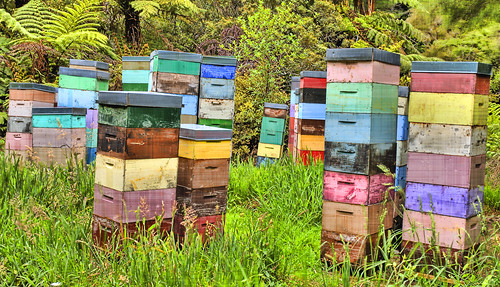 | ||
| Beehives from the north island of New Zealand. |
 | |
| Museum of Folk Architecture and Rural Life. Pyrohiv, Nr Kyiv. Over time historical buildings have been brought here from all over Ukraine to live the communal life of an open-air museum. The space is split into the regions of Ukraine so that the buildings are grouped by geographic origin. The beehives where used as such in the past, disused now. They have been brought from Volyn' a province in Western Ukraine. They are made from the trunks of trees and each one is slightly different; different trees lend themselves to different effects. Some of them are decorated, carved or have thatched rooves. Each trunk would have a section cut out which is used to hollow out the trunk and then the outer piece is refitted as a sort of 'door' into the inside. |
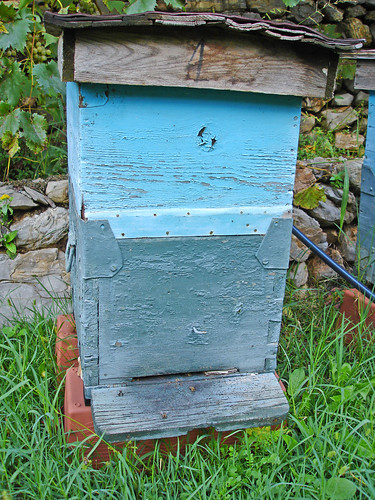 |
| Beehive. |
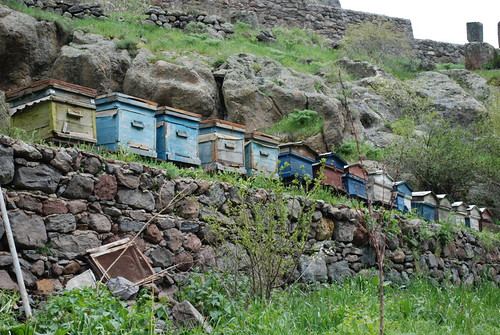 |
Beehives - Geghard Monastery - Armenia |
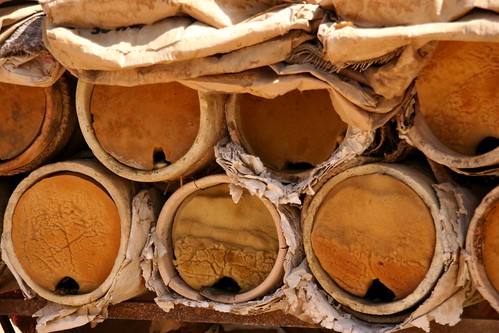 |
| Yemen |
 |
| Siberia. A nice cushion to keep them warm. |
 |
| Mobile beehives in Slovenia. |
 |
| More individually painted hives from Slovenia. Your Beeswax: More Beehives from around the world |
Genetically modified crops and their role with honeybees.
I came across a wonkish study that looked into the interactions of GMO's and honeybees. As with many other suspects of colony collapse, it showed some very real characteristics that could be contributing to CCD but still not exactly a smoking gun, just another piece in the puzzle of an unhealthy environment for pollinators.
The protein that is in BT crops (crops genetically altered to be poisonous to "pests") causes potential learning disabilities of bees that slows down the ability of the hive to be fully productive and forage effectively.
Of course none of these findings aren't anything a well paid corporate lawyer couldn't find enough holes in to drive a semi-truck of GMO corn syrup through. Tobacco attorneys were just as effective at avoiding empirical evidence and dragged litigation out for decades until a national settlement.
That is the nature of the problem, being that there are so many variables and no smoking gun, proving beyond a shadow of a doubt is nearly impossible.
GMO's also have the problem of being in the DNA of crops, DDT was found to be harmful and eventually was taken off the market. Extracting a piece of genetic code does not come off of store shelves, like DDT could be take off the market. GMO's have their place, increasing protein contents of crops for impoverished countries can very well be a net positive. If crops could be made to grow with partial sea water irrigation that could be a net positive for many countries in the world. All that being said, opening a Pandoras box by purposely making crops poisonous should treated much more judiciously. Getting a GMO crop out of the environment when turns out to be hazardous is like putting toothpaste back in the tube.
How do you undo DNA?
The original abstract:
The protein that is in BT crops (crops genetically altered to be poisonous to "pests") causes potential learning disabilities of bees that slows down the ability of the hive to be fully productive and forage effectively.
Of course none of these findings aren't anything a well paid corporate lawyer couldn't find enough holes in to drive a semi-truck of GMO corn syrup through. Tobacco attorneys were just as effective at avoiding empirical evidence and dragged litigation out for decades until a national settlement.
That is the nature of the problem, being that there are so many variables and no smoking gun, proving beyond a shadow of a doubt is nearly impossible.
GMO's also have the problem of being in the DNA of crops, DDT was found to be harmful and eventually was taken off the market. Extracting a piece of genetic code does not come off of store shelves, like DDT could be take off the market. GMO's have their place, increasing protein contents of crops for impoverished countries can very well be a net positive. If crops could be made to grow with partial sea water irrigation that could be a net positive for many countries in the world. All that being said, opening a Pandoras box by purposely making crops poisonous should treated much more judiciously. Getting a GMO crop out of the environment when turns out to be hazardous is like putting toothpaste back in the tube.
How do you undo DNA?
The original abstract:
Does Cry1Ab protein affect learning performances of the honey bee Apis mellifera L. (Hymenoptera, Apidae)?
Instituto de Ecologia A.C., Km. 2.5 Carretera Antigua a Coatepec No. 351 El Haya, 91070 Xalapa, Veracruz, Mexico.Abstract
Genetically modified Bt crops are increasingly used worldwide but side effects and especially sublethal effects on beneficial insects remain poorly studied. Honey bees are beneficial insects for natural and cultivated ecosystems through pollination. The goal of the present study was to assess potential effects of two concentrations of Cry1Ab protein (3 and 5000 ppb) on young adult honey bees. Following a complementary bioassay, our experiments evaluated effects of the Cry1Ab on three major life traits of young adult honey bees: (a) survival of honey bees during sub-chronic exposure to Cry1Ab, (b) feeding behaviour, and (c) learning performance at the time that honey bees become foragers. The latter effect was tested using the proboscis extension reflex (PER) procedure. The same effects were also tested using a chemical pesticide, imidacloprid, as positive reference. The tested concentrations of Cry1Ab protein did not cause lethal effects on honey bees. However, honey bee feeding behaviour was affected when exposed to the highest concentration of Cry1Ab protein, with honey bees taking longer to imbibe the contaminated syrup. Moreover, honey bees exposed to 5000 ppb of Cry1Ab had disturbed learning performances. Honey bees continued to respond to a conditioned odour even in the absence of a food reward. Our results show that transgenic crops expressing Cry1Ab protein at 5000 ppb may affect food consumption or learning processes and thereby may impact honey bee foraging efficiency. The implications of these results are discussed in terms of risks of transgenic Bt crops for honey bees.
More Mead Basics.
More information can be found here about mead making. The process is simple and good honey normally results in a very nice mead.
The Quick Guide to Making Mead
The Quick Guide to Making Mead
Posted by
Squidward
0
comments
Wednesday, July 28, 2010
Just like Mother Nature intended?
Spring time in an almond orchard is just starting to bloom. Bees are needed to pollinate thousands upon thousands of acres annually. As a thought experiment, would you suppose that you would see one species of tree over a square mile. Even if there is such a forest, it would still have diversity in the underbrush , natural pollinators would have habitat to live in and a variety of blossoms to forage. Grass and almond blossoms don't give the bees much variety for pollen, nectar the tree resins that they bring into the hive. Most people would get sick if they only ate one type of food three meals a day. I take it bees aren't much different and can have their immune systems compromised without a balanced diet.
Below is a Florida orange grove from a satellite, it covers square miles. The lessons that improved agriculture and expanded production pulling us out of the dark ages was that of crop rotation and avoiding monoculture. The corporate mantra of economies of scale is running head long into the laws of nature. Eventually we will have to rethink the nature of our food supply, forced or willingly. Replicating the systems and patterns found in nature will help solve the problems but are not as sexy and easily sold as a GMO or new pesticide that improves crop yields by X%. The economic model needs to change to saving on costs of fertilizers, chemicals and seeds from maximizing production per acre and national distribution. Smaller yields can be offset by shorter shipping distances and a diversity of produce that prevent their ever being a failed crop because there is always a successful crop elsewhere on the farm that the farmer has available to sell.
View Larger Map
Another Pesticide to add to the suspects list for Colony Collapse Disorder: Fipronil
I came across a good piece on a common pesticide that has been known for a while as a contributor to CCD. Again, it is not a single cause to solve the problem if we just eliminate it. The methods of industrial corporate agriculture are the root cause of CCD. Modern agriculture has been so far divorced from what occurs in nature that there has been collateral damage in the ecosystem.
Original text from here
Original text from here
"In sublethal doses, however, research has shown that imidacloprid and other neonicotinoids, such as fipronil, can impair honeybees' memory and learning, as well as their motor activity and navigation. When foraging for food and collecting nectar, honeybees memorize the smells of flowers and create a kind of olfactory map for subsequent trips.
However, in laboratory and field studies, honeybees exposed to imidacloprid seem to wander off, which may explain, say scientists, why hives all over the world are turning up empty.
Recent studies have reported on the "anomalous flying behavior" of imidacloprid-treated bees where the workaholic insects simply fall to the grass or appear unable to fly toward the hive.
In 2003, a French television documentary team filmed honeybee activity after exposure to imidacloprid. Clumsy and uncoordinated, their legs trembling, the bees looked like drunks unable to find the key to the front door of their hive. Others had trouble leaving the hive, seemed disoriented, and when they were eventually able to make their way out, soon disappeared, never to return.
The possibility that neonicotinoids are at the heart of the bee die-off implies a far more complex problem because of the widespread use of pesticides. Every year these chemicals are applied to hundreds of millions of acres of agricultural lands, gardens, golf courses and public and private lawns across the United States. Their use on major crops nearly tripled between 1964 and 1982, from 233 million pounds to 612 million pounds of active ingredients. And since then, their use has exploded. By 1999, the U.S. Environmental Protection Agency reported 5 billion pounds of pesticides used on U.S. crops, forests, lawns, flowers, homes and buildings.
Because of imidacloprid's emergence as a primary player in pest management, a painful paradox has developed in relation to the recent debate. Neonicotinoids are needed by farmers and growers to maintain the health of crops, many of which also require pollination by honeybees.
"Neonicotinoids are now the best aphid insecticide we have," said Peter Shearer, a specialist in fruit tree entomology with the Rutgers Agricultural and Extension Center in Bridgeton, N.J. "It's very important to our pests that have shown resistance to other chemicals. It's very important to eggplants, potatoes, tomatoes."
Shearer notes that apple farmers, for instance, don't use Provado, which has imidacloprid as an active ingredient, until after the bees, which are used for pollination, are removed from the orchards.
So it doesn't seem to be a logical route of bee die-off," he said. "It would have to last 11 months."
However, Shearer also acknowledges that some published studies indicate that imidacloprid can persist on both vegetation and in the soil for weeks, months and perhaps years.
In France, there have been inconsistent results since the bans on imidacloprid went into effect. In 2005, for the first time in a dozen years, the French honey harvest improved, but only in certain regions, according to the country´s beekeeping federation.
Some U.S. entomologists, who recently have been analyzing dead bees, have found a remarkably high number of viruses and fungal diseases in the carcasses, leading them to suspect there may be other culprits besides neonicotinoids.
A 2004 University of North Carolina study, for instance, found that some neonicotinoids, in combination with certain fungicides, increased the toxicity of the "neonics" to honeybees a thousand-fold.
"I don't think there is one smoking gun," said Hayes. "When neonicotinoids are used on termites, they can't remember how to get home, they stop eating and then the fungus takes over and kills them. That's one of the ways imidacloprid works on termites - it makes them vulnerable to other natural organisms. So if you look at what's happening to honeybees, that's pretty scary."
Last week the five-state Mid-Atlantic Apiculture Research and Extension Consortium released a progress report on colony collapse disorder. Its findings included "the high prevalence of fungi in adult bees" which seemed "indicative of stress or a compromised immune system; these symptoms have never been previously reported."
Another entomologist at the Rutgers center, Gerald Ghidiu, knows there is no simple answer to the problem.
They've been looking at this since the late 1990s," said the vegetable specialist. "They've done quite a few studies and they still can't find the direct link. Seventy-five percent of the vegetable crops in Arizona gets imidacloprid, but they have no problems with the honeybees right now. So why isn't it straight across the board? Everyone is in the dark over this."
Tuesday, July 27, 2010
KPBS piece on CCD
A well done piece on CCD talking about the multiple causes that may be responsible for it.
http://www.kpbs.org/audioclips/9754/
The original article is here.
"If they are treated with sub-lethal doses of pesticide, they actually will not come back to the nest, they may get lost. and one study suggests they actually will dance less," explained Nieh. "So their efficiency at recruiting other bees to that same food source is decreased and the colony is getting less food into it."
This is a troubling point. Being sub-lethal it is difficult to diagnose; hard to track down the source and just as difficult to be able to do something about it. The toughest part of solving this aspect of the problem is trying to get the pesticide or pesticides off the market. How do you prove a specific pesticide with a billion dollars in sales is doing this if you can hardly prove that it is lethal. Professional "scientists" on the corporate dole can easily find reasonable doubt on any specific pesticide and lay blame on another cause, this same strategy was effectively used by the tobacco industry for years.
http://www.kpbs.org/audioclips/9754/
The original article is here.
"If they are treated with sub-lethal doses of pesticide, they actually will not come back to the nest, they may get lost. and one study suggests they actually will dance less," explained Nieh. "So their efficiency at recruiting other bees to that same food source is decreased and the colony is getting less food into it."
This is a troubling point. Being sub-lethal it is difficult to diagnose; hard to track down the source and just as difficult to be able to do something about it. The toughest part of solving this aspect of the problem is trying to get the pesticide or pesticides off the market. How do you prove a specific pesticide with a billion dollars in sales is doing this if you can hardly prove that it is lethal. Professional "scientists" on the corporate dole can easily find reasonable doubt on any specific pesticide and lay blame on another cause, this same strategy was effectively used by the tobacco industry for years.
Friday, July 23, 2010
Basic Mead Making
The recipe I started out with was found here. I always thought cranberry and honey complimented each other. The pure unsweetened cranberry juice was about as pricey as the honey would be. Even with the "toddler of the house" monkeying with the air lock, I had very good results after about a year. I used more honey and didn't bother with the corn sugar. Typically the better the honey the better the end product. Don't a medal winning mead with bulk honey for baking that would avoid eating raw on toast or in tea.
Here is a basic run through of mead making and basic equipment.
More of the series can be seen here.
Let's Start out with the simplest three recipes:(5 gallon)
Dry Mead
* 12 lbs. of Honey
* 4 gallons of spring water
* 2 teaspoons of yeast nutrient
* 2 teaspoons of yeast energizer
* 2 packets of Lalvin 71b-1122 yeast (or a suitable replacement)
Medium Mead
* 15 lbs of Honey
* 4 gallons of spring water
* 2 teaspoons of yeast nutrient
* 2 teaspoons of yeast energizer
* 2 packets of Lalvin 71b-1122 yeast (or suitable replacement)
Sweet Mead
* 18 lbs of Honey
* 4 gallons of spring water
* 2 teaspoons of yeast nutrient
* 2 teaspoons of yeast energizer
* 2 packets of Lalvin 71b-1122 yeast (or suitable replacement)
These three recipes are the simple and no problem way to make a basic and great tasting mead. The only difference between them is the amount of honey you put into the must.
Here is a basic run through of mead making and basic equipment.
More of the series can be seen here.
Let's Start out with the simplest three recipes:(5 gallon)
Dry Mead
* 12 lbs. of Honey
* 4 gallons of spring water
* 2 teaspoons of yeast nutrient
* 2 teaspoons of yeast energizer
* 2 packets of Lalvin 71b-1122 yeast (or a suitable replacement)
Medium Mead
* 15 lbs of Honey
* 4 gallons of spring water
* 2 teaspoons of yeast nutrient
* 2 teaspoons of yeast energizer
* 2 packets of Lalvin 71b-1122 yeast (or suitable replacement)
Sweet Mead
* 18 lbs of Honey
* 4 gallons of spring water
* 2 teaspoons of yeast nutrient
* 2 teaspoons of yeast energizer
* 2 packets of Lalvin 71b-1122 yeast (or suitable replacement)
These three recipes are the simple and no problem way to make a basic and great tasting mead. The only difference between them is the amount of honey you put into the must.
Posted by
Squidward
0
comments
Thursday, July 22, 2010
Plans for your own Top Bar Hive
How to Build a Top Bar Hive
More info on building your own top bar hive from scrap wood you may already have. The simple practical design is perfect for the backyard beekeeper.
More info on building your own top bar hive from scrap wood you may already have. The simple practical design is perfect for the backyard beekeeper.
Wednesday, July 21, 2010
Building Top Bar Hives
Top bar hives are becoming very popular for hobbyist beekeepers. The design replicates the bees natural environment better than commercial hives. The hanging combs help prevent mites, the mites are unable to climb back onto the combs when they fall off. Eliminating mites eliminates the bees being exposed to the diseases that mites spread.
For the do-it-yourselfer here are instructions to build your own top bar hive.
For the do-it-yourselfer here are instructions to build your own top bar hive.
Pesticide and Colony Collapse Disorder.
I came across this article the other day. I have my doubts that there is any single culprit causing colony collapse but I have always figured that pesticides are a large part of the puzzle.
Insecticide suspected in bee Colony Collapse Disorder
FALMOUTH, Maine (NEWS CENTER) -- We need bees to pollinate our plants. But bees are disappearing.
Colony Collapse Disorder is name that has been given to the sudden disappearance of bee colonies.
The bees are getting disoriented for some reason. They can't find their way back to the hive and they eventually die. Some scientists now believe the bee disorientation could be due to a pesticide called Imidacloprid, a synthetic nicotine used in pesticides. Paul Tukey's group, Safelawns.org is asking people to avoid pesticides that include Imidicloprid.
There are many organic alternatives in pest control now on the market. One of Paul's favorites is Eco-Smart. The active ingredients are peppermint, cinnamon and sesame seed oils. All are considered food grade, and safe.
Paul says you still want to read the labels of the organic products and use the proper protection.
original article here
Insecticide suspected in bee Colony Collapse Disorder
FALMOUTH, Maine (NEWS CENTER) -- We need bees to pollinate our plants. But bees are disappearing.
Colony Collapse Disorder is name that has been given to the sudden disappearance of bee colonies.
The bees are getting disoriented for some reason. They can't find their way back to the hive and they eventually die. Some scientists now believe the bee disorientation could be due to a pesticide called Imidacloprid, a synthetic nicotine used in pesticides. Paul Tukey's group, Safelawns.org is asking people to avoid pesticides that include Imidicloprid.
There are many organic alternatives in pest control now on the market. One of Paul's favorites is Eco-Smart. The active ingredients are peppermint, cinnamon and sesame seed oils. All are considered food grade, and safe.
Paul says you still want to read the labels of the organic products and use the proper protection.
original article here
Thursday, May 20, 2010
Urban beekeeping
I have spoken to several urban beekeepers while doing the farmers markets all have interesting stories especially the ones from New York. Apparently each of the five boroughs have distinct flavors of honey. From what I hear beekeeping in NYC is no longer a clandestine operation and can be done legally now.
http://www.nytimes.com/2010/03/15/science/earth/15bees.html
Bees in the City? New York May Let the Hives Come Out of Hiding
Michelle V. Agins/The New York Times
Kathleen Boyer suspects the mailman.
She said she could not think of anyone else in her neighborhood who would have complained about the two beehives she kept under a pine tree in her front yard in Flatbush, Brooklyn, leading the city’s health department to fine her $2,000 last fall.
“I was kind of surprised,” said Mrs. Boyer, an art director with a media company. “People see us in our bee suit and they’d bring their kids to watch us and ask us questions.”
New York City is among the few jurisdictions in the country that deem beekeeping illegal, lumping the honeybee together with hyenas, tarantulas, cobras, dingoes and other animals considered too dangerous or venomous for city life. But the honeybee’s bad rap — and the days of urban beekeepers being outlaws — may soon be over.
On Tuesday, the Department of Health and Mental Hygiene’s board will take up the issue of amending the health code to allow residents to keep hives of Apis mellifera, the common, nonaggressive honeybee. Health department officials said the change was being considered after research showed that the reports of bee stings in the city were minimal and that honeybees did not pose a public health threat.
The officials were also prodded by beekeepers who, in a petition and at a public hearing last month, argued that their hives promoted sustainable agriculture in the city.
A ban, of course, has not deterred many New Yorkers from setting up hives on rooftops and in yards and community gardens, doing it as a hobby, to pollinate their plants or to earn extra income from honey. Although the exact number of beekeepers in the city is unknown, many openly flout the law. They have their own association, hold beekeeping workshops, sell their honey at farmers’ markets and tend to their hives as unapologetically as others might jaywalk, blaming their legal predicament on people’s ignorance of bees.
“People fear that if there’s a beehive on their rooftop, they’ll be stung,” said Andrew Coté, president of the New York City Beekeepers Association, which was formed two years ago and has 220 members.
“Honeybees are interested in water, pollen and nectar,” he said. “The real danger is the skewed public perception of the danger of honeybees.”
Still, some beekeepers say their renegade status causes headaches.
Sam Elchert, 22, a Columbia University student who is majoring in writing and philosophy, said it took him months to find a suitable home for his hives, which resemble short wood filing cabinets with movable frames inside. His building’s management turned him down, fearing legal problems because of the hives, he said. A community garden in Brooklyn welcomed the hives, but wanted them tucked away in the bushes where they would not get the sunlight they needed.
A friend of Mr. Elchert’s, who owned a brownstone in Manhattan complete with a backyard, declined to house the hives because his father was a lawyer, Mr. Elchert said. So did Columbia, where officials in charge of dining services and some green roofs said no, though they were supportive.
A teacher hosted the bees on her farm in Connecticut for a couple of months while Mr. Elchert kept up his search for a home for his hives. Finally, in June, a community garden in Harlem agreed, and Mr. Elchert goes there every other week to tend to the hives. He said that an article he read last year about beekeeping introduced him to the hobby, which he finds “oddly relaxing,” he said. He said he had also read about declines in the bee population and wanted to do his part to nurture the insects.
“It is a good cause, and there’s some sense of morality, even if we’re not on the right side of the law,” he said.
But Mr. Elchert admits that so far he has found his hobby more “nerve-racking” than relaxing, and inspects the garden only on weekdays to avoid weekend crowds.
“What if somebody, some cop, sees me?” he said. “It’d cost me $2,000. It’d really ruin my day.”
Busted beekeepers, as it turns out, are not exactly common. In 2009, 53 inspections were conducted in response to calls related to the harboring of bees and wasps, health officials said, and 13 resulted in notices of violation and fines of $200 to $2,000. In 2008, 48 inspections were made and 7 citations were issued.
Beekeepers say that beekeeping is a relatively low-maintenance and inexpensive endeavor — Mr. Elchert said he spent $500 on hives, equipment and about 20,000 bees to start.
Recently, 70 people filled a room in Lower Manhattan for an “Urban Beekeeping 101” workshop held by the New York City Beekeepers Association.
The class seemed more concerned about the challenges of keeping hives in tight, tall spaces than with the legality of beekeeping, asking questions like: “How high should the hives be?” (About five stories.) And “How much space is needed around the hives so that the bees can fly out to pollinate?” (At least 10 feet.)
But some students were worried about their liability should someone be stung, a hazard that leads most beekeepers to wear protective gear when they tend their hives.
“I’m not even allowed on the roof of my building,” said Matt Griffin, 33, a cook from Queens who said he would probably wait for the law to change and figure out “a few issues” before setting up his hives.
Katrinka Moore, 56, a poet and book editor in the financial district, said that if the law changed, she would ask neighboring churches to host her bees.
That would mean an end to life on the run for Mrs. Boyer’s two hives. They are now lodged with a friend — Mrs. Boyer would not say where — but she plans to retrieve them once they are legal.
Mrs. Boyer said that she and her husband, Chico, took up beekeeping last year so that they could teach workshops in Haiti, where Mr. Boyer was born.
The earthquake has delayed the couple’s plans, but their hives are thriving with 80,000 bees that have yielded more than 100 pounds of honey.
“We gave it to friends for Christmas,” Mrs. Boyer said. “They love it. Everybody is asking for more.”
Ms. Moore said that after working in advocacy against gas drilling in upstate New York, she looked to beekeeping for some relief.
She said: “You get honey. You’re also pollinating gardens. It’s such a positive, happy thing to do.”
Brooklyn's Urban Beekeepers: Breaking The Law For The Planet (Part I) from SkeeterNYC on Vimeo.
Brooklyn's Urban Beekeepers: "Watch Out Ladies" Honey Harvest from SkeeterNYC on Vimeo.
http://www.nytimes.com/2010/03/15/science/earth/15bees.html
Bees in the City? New York May Let the Hives Come Out of Hiding
Michelle V. Agins/The New York Times
Kathleen Boyer suspects the mailman.
She said she could not think of anyone else in her neighborhood who would have complained about the two beehives she kept under a pine tree in her front yard in Flatbush, Brooklyn, leading the city’s health department to fine her $2,000 last fall.
“I was kind of surprised,” said Mrs. Boyer, an art director with a media company. “People see us in our bee suit and they’d bring their kids to watch us and ask us questions.”
New York City is among the few jurisdictions in the country that deem beekeeping illegal, lumping the honeybee together with hyenas, tarantulas, cobras, dingoes and other animals considered too dangerous or venomous for city life. But the honeybee’s bad rap — and the days of urban beekeepers being outlaws — may soon be over.
On Tuesday, the Department of Health and Mental Hygiene’s board will take up the issue of amending the health code to allow residents to keep hives of Apis mellifera, the common, nonaggressive honeybee. Health department officials said the change was being considered after research showed that the reports of bee stings in the city were minimal and that honeybees did not pose a public health threat.
The officials were also prodded by beekeepers who, in a petition and at a public hearing last month, argued that their hives promoted sustainable agriculture in the city.
A ban, of course, has not deterred many New Yorkers from setting up hives on rooftops and in yards and community gardens, doing it as a hobby, to pollinate their plants or to earn extra income from honey. Although the exact number of beekeepers in the city is unknown, many openly flout the law. They have their own association, hold beekeeping workshops, sell their honey at farmers’ markets and tend to their hives as unapologetically as others might jaywalk, blaming their legal predicament on people’s ignorance of bees.
“People fear that if there’s a beehive on their rooftop, they’ll be stung,” said Andrew Coté, president of the New York City Beekeepers Association, which was formed two years ago and has 220 members.
“Honeybees are interested in water, pollen and nectar,” he said. “The real danger is the skewed public perception of the danger of honeybees.”
Still, some beekeepers say their renegade status causes headaches.
Sam Elchert, 22, a Columbia University student who is majoring in writing and philosophy, said it took him months to find a suitable home for his hives, which resemble short wood filing cabinets with movable frames inside. His building’s management turned him down, fearing legal problems because of the hives, he said. A community garden in Brooklyn welcomed the hives, but wanted them tucked away in the bushes where they would not get the sunlight they needed.
A friend of Mr. Elchert’s, who owned a brownstone in Manhattan complete with a backyard, declined to house the hives because his father was a lawyer, Mr. Elchert said. So did Columbia, where officials in charge of dining services and some green roofs said no, though they were supportive.
A teacher hosted the bees on her farm in Connecticut for a couple of months while Mr. Elchert kept up his search for a home for his hives. Finally, in June, a community garden in Harlem agreed, and Mr. Elchert goes there every other week to tend to the hives. He said that an article he read last year about beekeeping introduced him to the hobby, which he finds “oddly relaxing,” he said. He said he had also read about declines in the bee population and wanted to do his part to nurture the insects.
“It is a good cause, and there’s some sense of morality, even if we’re not on the right side of the law,” he said.
But Mr. Elchert admits that so far he has found his hobby more “nerve-racking” than relaxing, and inspects the garden only on weekdays to avoid weekend crowds.
“What if somebody, some cop, sees me?” he said. “It’d cost me $2,000. It’d really ruin my day.”
Busted beekeepers, as it turns out, are not exactly common. In 2009, 53 inspections were conducted in response to calls related to the harboring of bees and wasps, health officials said, and 13 resulted in notices of violation and fines of $200 to $2,000. In 2008, 48 inspections were made and 7 citations were issued.
Beekeepers say that beekeeping is a relatively low-maintenance and inexpensive endeavor — Mr. Elchert said he spent $500 on hives, equipment and about 20,000 bees to start.
Recently, 70 people filled a room in Lower Manhattan for an “Urban Beekeeping 101” workshop held by the New York City Beekeepers Association.
The class seemed more concerned about the challenges of keeping hives in tight, tall spaces than with the legality of beekeeping, asking questions like: “How high should the hives be?” (About five stories.) And “How much space is needed around the hives so that the bees can fly out to pollinate?” (At least 10 feet.)
But some students were worried about their liability should someone be stung, a hazard that leads most beekeepers to wear protective gear when they tend their hives.
“I’m not even allowed on the roof of my building,” said Matt Griffin, 33, a cook from Queens who said he would probably wait for the law to change and figure out “a few issues” before setting up his hives.
Katrinka Moore, 56, a poet and book editor in the financial district, said that if the law changed, she would ask neighboring churches to host her bees.
That would mean an end to life on the run for Mrs. Boyer’s two hives. They are now lodged with a friend — Mrs. Boyer would not say where — but she plans to retrieve them once they are legal.
Mrs. Boyer said that she and her husband, Chico, took up beekeeping last year so that they could teach workshops in Haiti, where Mr. Boyer was born.
The earthquake has delayed the couple’s plans, but their hives are thriving with 80,000 bees that have yielded more than 100 pounds of honey.
“We gave it to friends for Christmas,” Mrs. Boyer said. “They love it. Everybody is asking for more.”
Ms. Moore said that after working in advocacy against gas drilling in upstate New York, she looked to beekeeping for some relief.
She said: “You get honey. You’re also pollinating gardens. It’s such a positive, happy thing to do.”
Brooklyn's Urban Beekeepers: Breaking The Law For The Planet (Part I) from SkeeterNYC on Vimeo.
Brooklyn's Urban Beekeepers: "Watch Out Ladies" Honey Harvest from SkeeterNYC on Vimeo.
Sunday, May 9, 2010
Wednesday, May 5, 2010
A Cookbook Featuring Our Bees and Honey!

From wild chanterelle mushrooms and Walla Walla onions to marionberries and hazelnuts, the Pacific Northwest produces some of the country's most delicious food. "The Northwest Vegetarian Cookbook" features 200 fresh, accessible recipes that celebrate these unique flavors. It also profiles twelve growers and beekeepers of Oregon and Washington through inspiring essays that transport the reader to the farm where food is picked from trees, bushes, and vines. Debra Daniels-Zeller has created a great culinary reference and an introduction to the bounty of local markets, with tips on how to buy and store seasonal produce. This title includes breakfast foods, year-round salads, soups and breads, starters and sides, entrees, and desserts. Readers will walk away from this book - and straight to the local farmers' market - with recipes for each season and every part of the day.
It can be found here.
Subscribe to:
Posts (Atom)



